Top 10 Guidelines for a Successful Business Intelligence Strategy
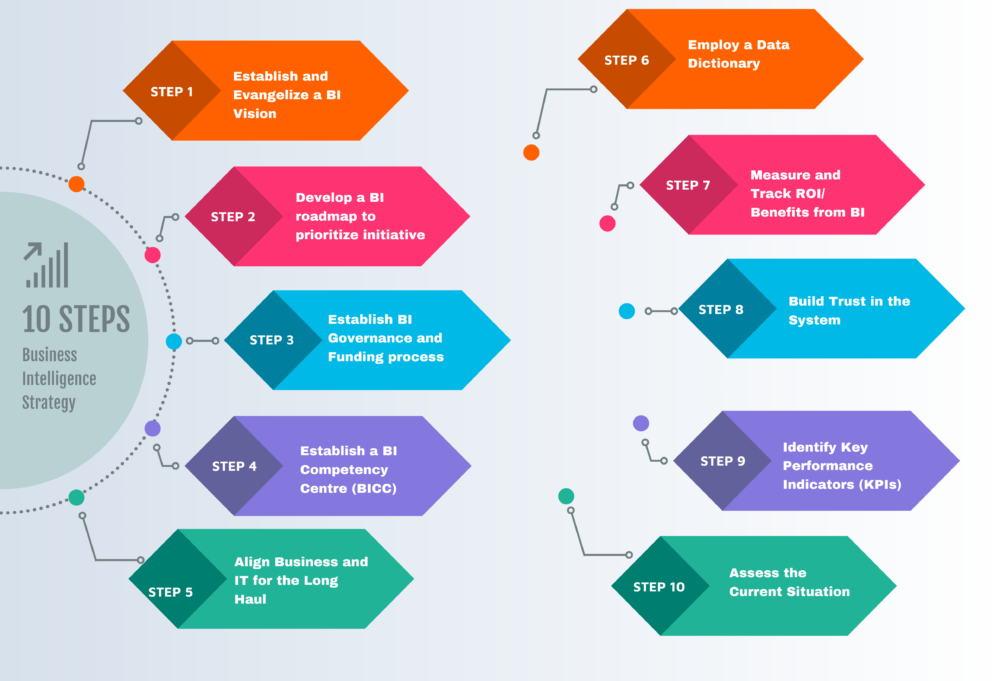
Most businesses anticipate having a competitive advantage, will reap profits leading to an eventual business growth. For the business to reach its potential growth, it need to have a good Business Intelligence technology as its backbone.
Business intelligence systems, are designed to improve decision making in enterprises, and became an important part of management in recent years. Business Intelligence system presents a complex task, technology and applications of information systems which strongly support the analytical and planning activities of enterprises and organizations.
Business Intelligence has many capabilities, such as reporting and querying, complicated analysis, data mining, prediction, forecasting, and much more. These capabilities and features in the Business Intelligence tools make it as the Decision Support Systems (DSS), Executive Information Systems (EIS) and Data Warehousing (DW) of today's growing businesses.
Business Intelligence is a broad category of software applications and technologies used to gather, store, analyse, and access data to help organizations make better business decisions. BI capabilities have progressed significantly allowing easier access and consolidation of data from multiple and with the delivery of flexible analytical tools to staff at all levels in organizations.
The Business Intelligence Strategy is a roadmap that enables organisations to assess their current situation, measure their performance and seek out a roadmap for competitive advantages with process, solution and architecture.
You may like to read: Top Extract, Transform, and Load, ETL Software and How to Select the Best ETL Software for Your Business
Top 10 Guidelines for a Successful Business Intelligence Strategy
Business Intelligence (BI) strategy is a plan for an organization's use of data and analytics to support decision-making and drive success. The strategy outlines how data will be collected, managed, analyzed, and presented to stakeholders to provide insights and inform business decisions. A BI strategy typically includes components such as a data strategy, analytics strategy, reporting and visualization strategy, organizational alignment, technology plan, security and privacy plan, and talent and skills plan. The goal of a BI strategy is to create a centralized and integrated approach to using data and analytics to drive business outcomes.
A Business Intelligence (BI) strategy is a plan that outlines how an organization will use data and analytics to support decision-making and drive success. A typical BI strategy includes the following components:
- Data strategy: Defines the types of data the organization will collect, how it will be stored and managed, and the processes for ensuring data quality and accuracy.
- Analytics strategy: Outlines the tools and techniques the organization will use to turn data into insights, and how analytics will be used to support decision-making.
- Reporting and visualization strategy: Specifies how data and insights will be presented to stakeholders, including dashboards, reports, and other data visualizations.
- Organizational alignment: Ensures that all departments are aligned with the BI strategy, and that the strategy is integrated into the organization's overall business strategy.
- Technology plan: Identifies the software and hardware necessary to support the BI strategy, and outlines a plan for implementing and maintaining these tools.
- Security and privacy plan: Ensures that sensitive data is protected and that the privacy of individuals is safeguarded.
- Talent and skills plan: Addresses the need for data literacy and analytics skills within the organization, and outlines a plan for developing these skills in existing employees or hiring new talent.
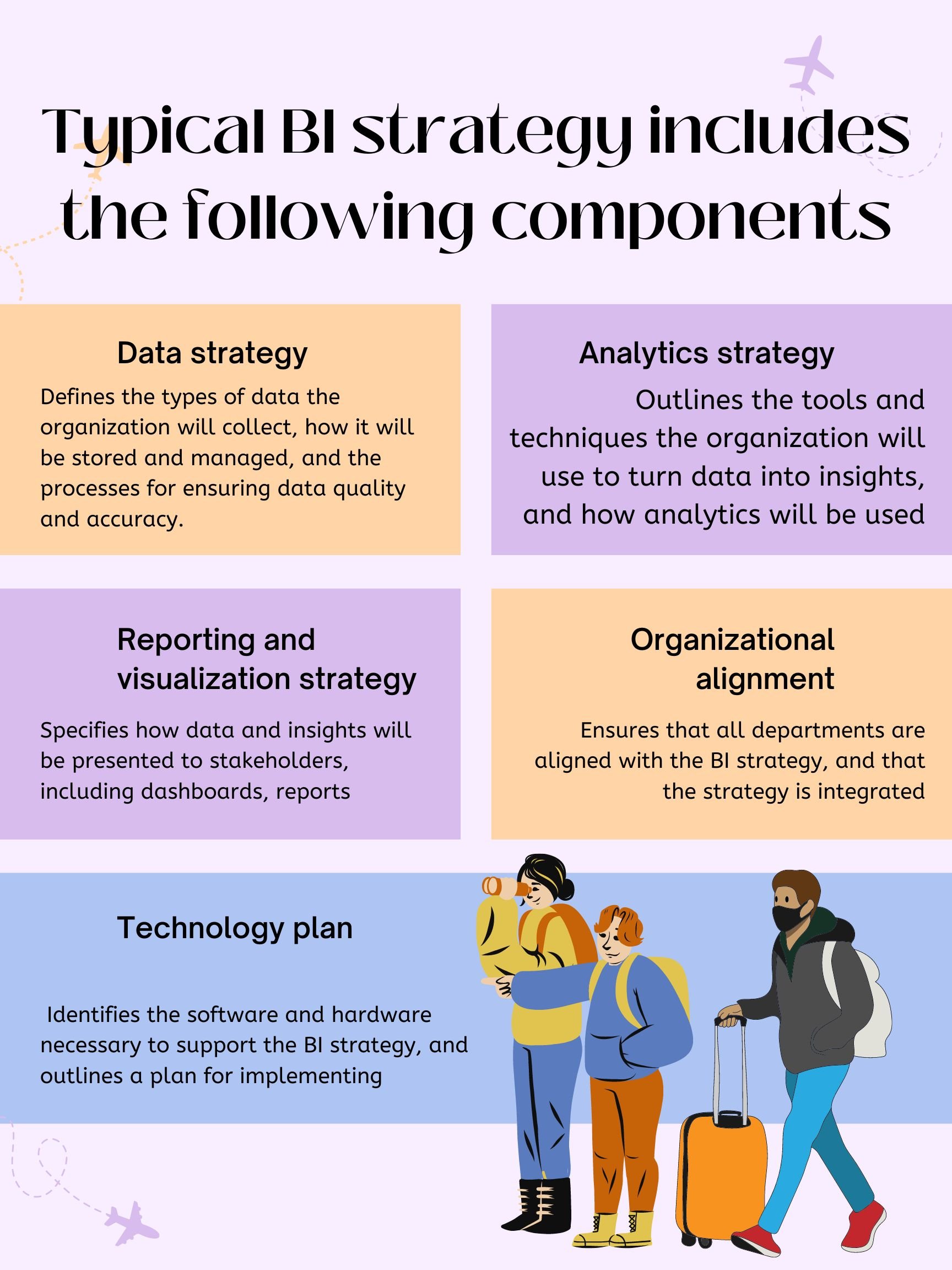
Typical BI strategy components
For BI strategies to be met in an organization, there have to be some guidelines that need to adhere. Below are the ten guidelines for a successful Business Intelligence:
BI Guideline 1 - Establish and Evangelize a BI Vision
Just as every business has a vision, there should be a vision for the BI system. The enterprise should determine the role in which the BI technology and is base technology vision it will play in ensuring the business strategies are met.
Determine the key business drivers, the vision which guides the data subject sections and drives the business unit. Ensure the business initiatives, that guides the knowledge assets and drive the system required. The important thing is to have the BI strategies embedded with the business operations. Having the right tool enables to understand your customers need and you are in a position to provide a product that is able to meet your growing demand.
BI Guideline 2 - Develop a BI roadmap to prioritize initiative
Not all empires are built in a day so is a successful BI. The enterprise should prioritize the strategic value, simplicity of executions and the initiatives of the business by the ROI. Outline the cost saving from data by centralization and the mart consolidation.
Develop a guideline for the integration of the BI with the maximum cost that is funded through benefits generations and the centralized benefits. Ensure that BI roadmap works hand in hand to ensure that the business initiatives are prioritized to meet the business vision.
The business should have an insight of what they want and which among is critical so that the BI can work to deliver what important to the business user first as it work on the priority list. Focus on the business problem first than the data will follow.
You may like to read: Business Intelligence Tools and the Types of Business Intelligence Software
BI Guideline 3 - Establish BI Governance and Funding process
Like any organization, there has to be structures that will ensure good governance of the company to ensure smooth functionality. The BI technology also needs an established governance setup, data governance executives, teams and boards. There is need for an established support structures and business intelligence communities that leads to its success.
Good governance is possible is there is adequate funds to support it. So as to launch the project well the business owners need to secure enough funds from sponsors. After the launch they need to also sustain the funding over the life of the BI, allocate funds that will build the enterprise BI infrastructure and maintain it.
BI should be sponsor by an individual who has broad understanding of the company strategies, bottom-line responsibility and knows how to attain the companies’ vision into missions oriented KPIs.
BI Guideline 4 - Establish a BI Competency Centre (BICC)
An enterprise that utilize BI Technology had a wide data warehouse, thus it creates a need of skilled data analyst to manage it and that’s where BICC comes in. Business Intelligence Competency Centre (BICC) is a central pool of skilled specialist and resources that can be distributed and shared in all units of a business.
They are a full-time drivers mostly in the data warehouse, who are expertise in data models and specialized analysis techniques. The BICC is the key driver of creating EDW awareness and initiatives.
You may like to read: Top Best Practices in Reporting Software
BI Guideline 5 - Align Business and IT for the Long Haul
Not all bi Project will succeed in a go, it will take an enterprise years to implement the scope to achieve its success. Without the right team of business people and developer team who will collaborate in all means possible to ensure that they provide not only correct information but also actionable to the individuals that need it.
You have to ensure that is an alignment between the IT development team and that of business. This can be made possible by the use of joint applications development sitting, whereby you bring both teams together and establish a common understand among them. BI is not an initiative that only requires IT expertise but also business users should be involved throughout the project.
BI Guideline 6 - Employ a Data Dictionary
Data dictionaries are challenging to any business. Extensive documentation and agile development have led to these large data dictionaries which can be hard and time-consuming keep then updated.
There has to be a consensus on business calculations and data definition for a BI to succeed because the lack of it is among one of the problem facing many companies today. A good example is sales and finance department they both define “gross margin” differently, thus their numbers may not match. Business should establish out the definitions and choose which best suits their company.
You may like to read: Top Challenges every organization face in Business Intelligence
BI Guideline 7 - Measure and Track ROI/ Benefits from BI
BI is not a short-term project rather a journey. But most of the time an organization along the way will lose sight of what is the original objective of BI. The only way to avoid such is by ensuring that the business starts small and increase with that baseline.
With that it will make it easier to track the ROI and to measure the benefits that are derived from tangible and intangible BI. When there is a clear demonstration of losses it imply the business needs to go back to the drawing boards and find ways of improvements but when there is success it brings confidence to progress to meet the business goals.
BI Guideline 8 - Build Trust in the System
There are a thousand ways to decrease the credibility of the system but a few ways to directly impact it positively. The only way to ensure that a BI solution works well or rather build trust in it, is by ensuring the right team owns the solution and make decision according to their predefined expertise. One good example will be the technical expertise should be in control of decisions related to (data model, design and validation).
Teams need to prevent problematic data from entering the BI system thus producing faulty, thus ensure a strong validation process that’s quick enough to respond to requests for new BI functions. IT team ought to ensure that the technical environment is bulletproof, meaning it can adapt quickly to changes in business requirements.
BI Guideline 9 - Identify Key Performance Indicators (KPIs)
For a BI to succeed set data definitions have to be adhered and right KPIs determined. KPIs are values that show how a business is attaining its objective effectively, which are at the center of a good BI strategy.
When implement the BI it is important to ensure KPIs are aligned to business strategies to achieve its objectives. At times you may want to create a KPIs for everything in a company, which might be wrong. The best way to handle that would be starting with the most significant KPIs and then create standards on the KPIs because there is always room to expand later.
You may like to read: Why Small Businesses Need Business Intelligence Software
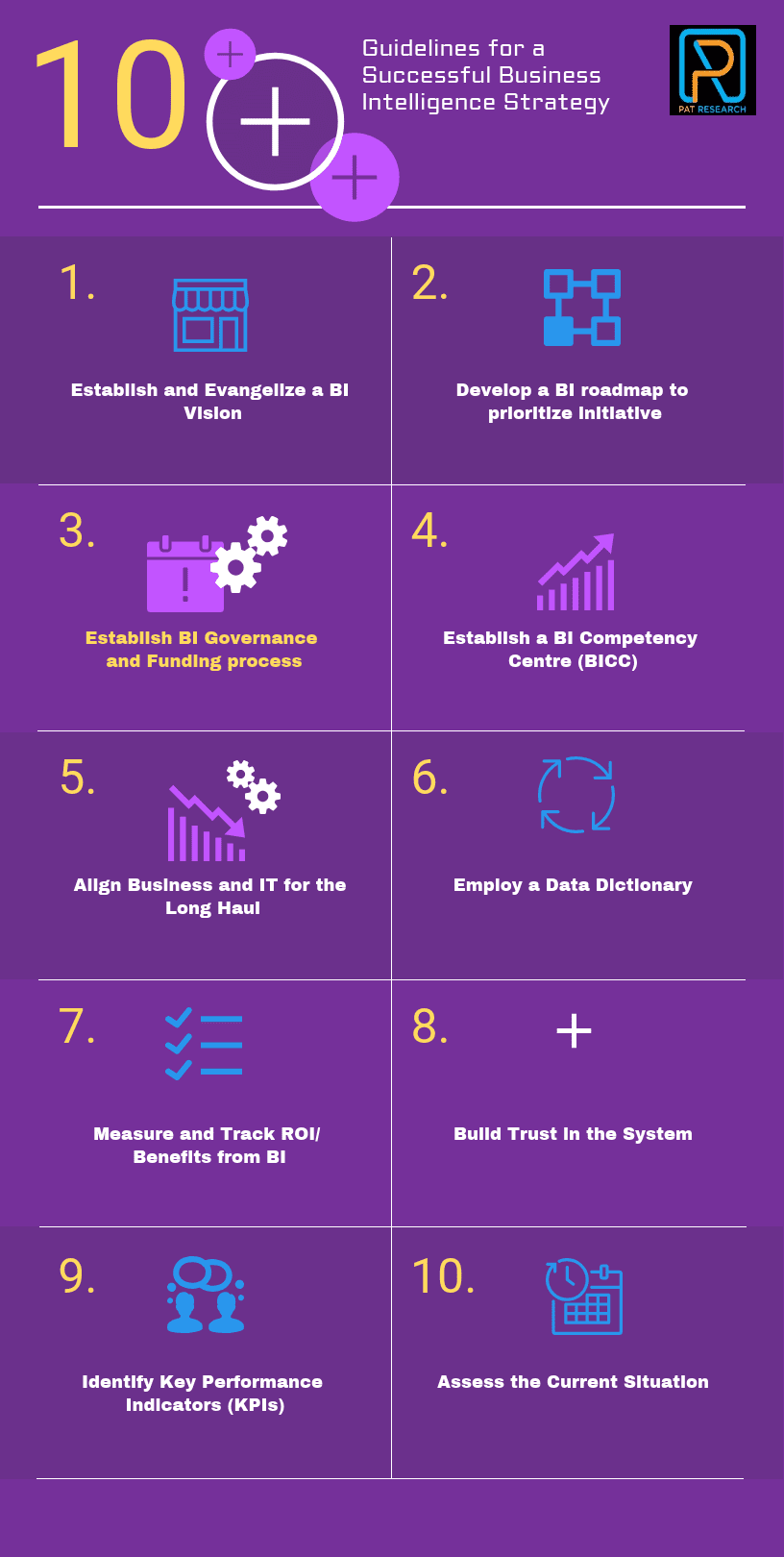
Guidelines for a Successful Business Intelligence Strategy
BI Guideline 10 - Assess the Current Situation
As mentioned above BI deployment isn’t easy or fast, business ought to put some work on the front end. Now that we have the right stakeholders, organization structures are streamlined the next step is analyzing the current software. First find out what is working for the business, because you wouldn’t want to scrap an already essential process.
Next would be finding out ways of integrating the new strategy to the business without affecting the employees and their work. On that you should be documenting on which processes are broken and what business questions are you unable to answer.
You need to compile on how data is being stored and which data sources you currently have. Decide on the business intelligence strategy that you will use and use that to create a plan for the data storage. On these you can either decide if there is a need of building data warehouse in your organization or the data source going to remain disparate?
You may like to read: Top Extract, Transform, and Load, ETL Software and How to Select the Best ETL Software for Your Business
Conclusion
On these steps, it’s vital that both business stakeholders and IT be significantly involved throughout the phases. Businesses have started embracing BI solutions and embedding it with traditional solutions to meet business objectives.
The tools offer extended value throughout the enterprise making them increasingly popular. Data projects such as forecast, incentive compensation plans, elasticity exercise, products prices, reporting packages, business plans and more strongly benefit from analysis and automation of BI solutions.
Managers, staffs, and executives are responsible for making best decisions throughout the organization, which are based on the information they have. Then if the information relevancy, insight and timing improves, these means also their decisions will. BI technology applies relevancy to the decision, which enhances execution of company objectives. So if you want to improve the quality of your business decisions matters, invest in a good BI system.
A successful Business Intelligence (BI) strategy is important for organizations as it helps to turn data into actionable insights that inform decision-making, resulting in improved efficiency and effectiveness. A comprehensive BI strategy streamlines data collection, analysis, and reporting processes, reducing the time and resources needed for data-related tasks. By integrating the BI strategy with the organization's overall business strategy, organizations can ensure that their data and analytics efforts are aligned with their goals, giving them a competitive advantage over their peers. A successful BI strategy helps to foster a data-driven culture within the organization, where data and analytics are valued and used to support decision-making. Additionally, by implementing a data strategy, organizations can improve the quality and accuracy of their data, leading to more reliable insights and better decision-making. With a BI strategy in place, organizations can use data and analytics to prioritize and allocate resources effectively, leading to improved efficiency and better results.
Here are the trending and the top rated Business Intelligence Software for you to consider in your selection process:
You may like to read: Top Extract, Transform, and Load, ETL Software and How to Select the Best ETL Software for Your Business
What is Business Intelligence Strategy? Business Intelligence Strategy is a roadmap that enables organizations to assess their current situation, measure their performance and seek out a roadmap for competitive advantages with process, solution and architecture. What are the Top Guidelines for a Successful Business Intelligence Strategy? Some of the guidelines that need to adhere for success in BI are establishing and evangelizing a BI vision, developing a BI roadmap to prioritize initiative, establishing BI governance and funding process, establish a BI Competency Centre (BICC), aligning the business and IT for the long haul and many more. 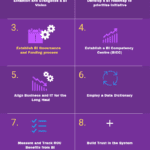

























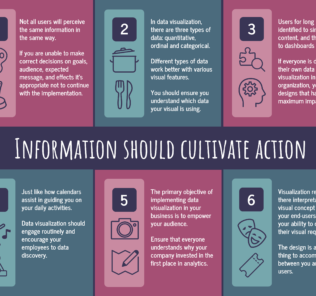
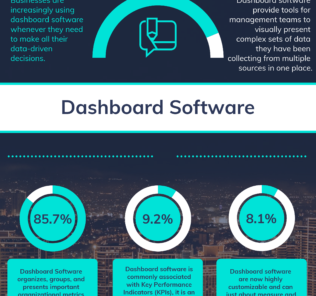
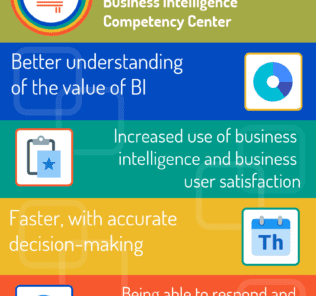
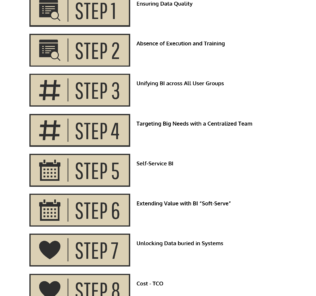
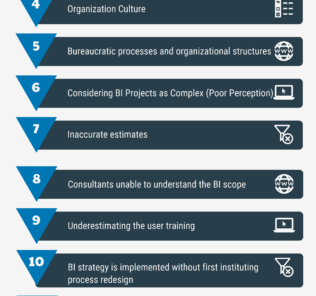
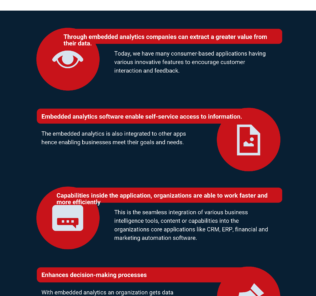




By clicking Sign In with Social Media, you agree to let PAT RESEARCH store, use and/or disclose your Social Media profile and email address in accordance with the PAT RESEARCH Privacy Policy and agree to the Terms of Use.